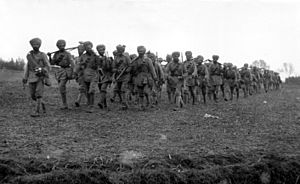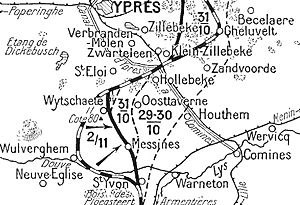Battle of Messines (1914) facts for kids
Quick facts for kids Battle of Messines (1914) |
|||||||
|---|---|---|---|---|---|---|---|
| Part of the Race to the Sea on the Western Front (First World War) | |||||||
 Messines area, 1914 |
|||||||
|
|||||||
| Belligerents | |||||||
|
|
|||||||
| Commanders and leaders | |||||||
| Edmund Allenby | Crown Prince Rupprecht | ||||||
The Battle of Messines was a fierce fight in October 1914. It took place during the early months of World War I. Armies from Germany, the British Empire, and France were involved. This battle was part of a larger series of events called the Race to the Sea. Both sides tried to outflank, or get around, the northern end of their enemy's army.
This "race" continued until the armies reached the North Sea. At that point, there was no more open land to go around. The Battle of Messines happened in a specific area. It was fought between the Douve River and the Comines–Ypres Canal in Belgium. The battle was very important for controlling this part of the Western Front.
Contents
Why the Battle Happened
The Race to the Sea
From mid-September to mid-October 1914, both sides tried to outsmart each other. They wanted to get around the enemy's northern side. Joseph Joffre, the French commander, moved his Second Army north. He hoped to find an open flank to attack.
At the same time, Erich von Falkenhayn, the German commander, also moved his Sixth Army north. He wanted to do the same thing. But instead of finding an open flank, the armies kept running into each other. This meant they were fighting head-on, not going around.
By late September, the French Second Army was fighting near Lille. They were still facing strong German forces. The German Sixth Army also found itself fighting the French. Their main goal became defending their own side.
Building Up Forces
By early October, the French needed help against German attacks. The British Expeditionary Force (BEF) began moving to Flanders. This area is in Belgium and France. British soldiers from England joined the French Tenth Army.
Both the Allies (Britain and France) and the Germans tried to gain more land. They kept trying to advance even after the "open" northern flank disappeared. The Germans also moved their Seventh and Sixth Armies. They wanted to protect their supply lines through Belgium. A new German Fourth Army was also formed. It included new reserve soldiers and heavy guns.
The Battlefield: Flanders
The area where the battle took place is called Flanders. It's in northwest France and southwest Belgium. West of a line from Arras to Calais, the land was chalky hills. East of this line, the land became flatter. It was a plain with many canals.
There was a line of low hills, including Mont Kemmel. From Kemmel, a ridge stretched northeast past Ypres and Messines. This ridge was important for observation. The coastal area was very flat and marshy. Inland, the land was mostly meadows. It had many canals, ditches, and raised roads.
The ground often turned very muddy, especially in autumn. This made it hard for soldiers to move. They often had to stick to the roads. The rest of Flanders had woods and small fields. Hedges and trees divided these fields. This made it hard to see far. It was also difficult for cavalry and artillery to move.
South of the La Bassée Canal was a coal-mining area. It had slag heaps and miners' houses. North of the canal were cities like Lille. These were manufacturing centers. The areas in between were mostly farms. Roads were often unpaved and muddy. This made travel very difficult for everyone.
Before the Battle Started
British Preparations
British cavalry divisions, led by General Allenby, moved first. They helped the III Corps gather at St. Omer and Hazebrouck. This was from October 10 to 12. The cavalry was ordered to go as far north as Ypres.
The British cavalry advanced on October 12. They found German soldiers dug in on hills like Mont des Cats. The British attacked these positions. The next day, they took more high ground. By October 14, they reached a line from Dranoutre to Wytschaete.
On October 15, the cavalry was told to explore the Lys River. They captured Estaires. But German defenses stopped them from going past Comines. This was west of Menin. German troops had arrived there during the night. The British gained a small foothold at Warneton.
By the end of October 15, the British cavalry held the Lys River. They also held the Comines Canal to Ypres. The BEF was ordered to advance on October 16. The Germans were falling back in some areas. But a German reserve corps was moving west from Antwerp.
The cavalry tried to cross the Lys River on October 16. It was foggy, so planes couldn't fly. Artillery couldn't help either. The river was muddy and shallow. Its banks had many boggy streams. This kept the cavalry on the roads.
German outposts were pushed back. But the river crossings were well defended. Dismounted cavalry attacks could not move the Germans. The attack continued on October 18. But the British made no progress against strong German defenses. By October 18, the British cavalry had suffered about 175 casualties.
The Battle of Messines
A German attack threatened the British 1st Cavalry Division. They held their position on Messines Ridge. But they had many casualties. The 3rd Cavalry Brigade was shelled out of its positions. The British line had to pull back.
There was some confusion about orders. But the British launched a counter-attack. They quickly recaptured the lost ground. This was against the German Cavalry Corps. The German commander, Gustav von Hollen, was replaced.
To the south, the 2nd Cavalry Division faced German artillery fire. The British commander, Gough, had only about 1,500 men and ten guns. This was far fewer than needed to defend the area. The Germans forced the 3rd Cavalry Brigade out of position. German units were close to Ypres. But they did not push further.
The 1st Cavalry Division stopped German attacks aimed at Messines. Foch, the French commander, sent reinforcements. He sent eight battalions to Hollebeke. He also sent the French 32nd Division to St Eloi.
In the morning, a German attack tried to break through. They aimed between Messines and the Comines Canal. This area was held by the British Cavalry Corps. German forces began a big assault on the evening of October 30.
The German 26th Division attacked at 4:30 a.m. They broke into Messines after five hours of fighting. About 6,000 German soldiers faced fewer than 900 British cavalrymen. The British fought house-to-house. They slowly retreated from the town.
Around noon, more British brigades arrived. They advanced towards Messines. These brigades fought the German 6th Bavarian Division. This stopped the Germans from helping their 26th Division. Both sides suffered many losses.
North of Messines, the 2nd Cavalry Division fought other German units. Gough received some French artillery and Indian soldiers. But they were still outnumbered by about 16,000 German infantry. The French sent more troops.
Wytschaete was held by only 415 British soldiers. The ridge between Wytschaete and Messines was held by 600 British soldiers. They faced six German battalions. The British were slowly forced back from their positions. Wytschaete fell at 2:45 a.m. But the Germans struggled to secure the ridge.
More British troops were sent to retake the ridge and town. They failed at the ridge. But the Lancers recaptured the town. The British lost many soldiers trying to retake the ridge. The 1st Cavalry Division in the Messines area fell back. This exposed Messines to German artillery fire.
As long as Wytschaete (north of Messines) and Warneton (south of Messines) were held by the British, they could stop a German breakthrough.
To protect their retreat, the British shelled Messines. This stopped the Germans from getting too close. British planes also attacked German ground forces. In other areas, the Germans were less successful.
The German 3rd Division was brought up. They wanted to push the British out of Wytschaete. The French sent their 32nd Division to help the British in the town. The 39th Division was assigned to recapture Messines.
The 39th Division's attack failed. The French 32nd Division and the remaining British were pushed out of Wytschaete. The Germans suffered many casualties attacking the French. By November 1, the Germans had secured the line and both towns. But the ridges west of the Wytschaete–Messines line were still held by the French.
The British soldiers were exhausted. Most divisions had very few men left. The British 7th Division had only 2,380 men. It was pulled from the front line. A new division from Britain replaced it. The Germans also had heavy losses. They needed to rest and get more soldiers. The front became quiet. There were only small raids and heavy shelling of Ypres. The Germans made their last big effort against Ypres on November 10.
Aftermath
The Battle of Messines was officially declared "inconclusive." This means neither side won a clear victory. However, the battle was a key part of the larger "Race to the Sea." It showed that the war on the Western Front would become a long, difficult struggle. Both sides dug in, leading to trench warfare. This type of fighting would define much of World War I.






